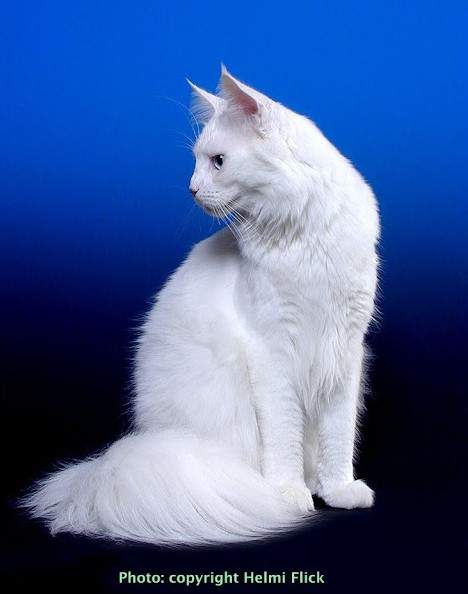It occurred to me that there needs to be a policy about the breeding of pure white cats because there is a severe disposition to deafness in cats with white fur caused by the dominant white gene (Leukism).
Breeds with white fur are considered to have potential welfare problems. The underlying ethics of cat breeding is not to breed cats with welfare problems. That must be the default situation at all cat associations and in all forms of selective breeding.
Pure white cats are cats with no pigmentation within their hair strands. It is the dominant white gene (W) which prevents the pigmentation migrating into the hair strands or it prevents the production of pigmentation in melanocytes. I'm not quite sure which but the result is no pigmentation in the hair strands (Wrong? Please tell me in a comment).
 |
| This beautiful Maine Coon is deaf. They should not have been created |
The dominant white gene also causes a higher incidence of cancer and a lack of pigmentation and tapetum lucidum in the eyes. The high incidence of deafness when deliberately created through an unethical breeding should be banned.
And this got me thinking about what the cat associations do about it. And some of them do something about it I am pleased to note.
For example, the general breeding policy of the Governing Council of the Cat Fancy in the UK state on their website that, "From 1 June 2016 all white cats, regardless of breed, will require a certificate confirming Bilateral Hearing lodged with the GCCF in order to be registered as active".
My presumption is that the word "active" means the cat is able to compete at cat shows. So, there is a rule which prevents unethical breeding of white cats causing deafness
The International World EV states at 3.3 that, "For breeding white cats we recommend that white X coloured parents are mated. White parents as well as young white animals are to be tested for deafness by audiometric testing. Cats are to be permanently marked with a microchip before audiometric testing is completed. The microchip number will be noted in the audiometric test certificate regarding the animal."
I presume that this procedure is to identify white cats which are not deaf. Not all white cats are deaf but there is an unsatisfactorily high percentage.
It appears that the general rule is to never breed white cats with white cats otherwise you will get deaf kittens.
Regarding the Cat Fanciers' Association, the premier cat association in the USA, I cannot find anything about the ethical breeding of pure white cats on their website. That may be due to a poor search engine but for whatever reason I can't find it. The same applies to The International Cat Association, another premier American cat association.
The conclusion is that white cats need to be selectively bred with care to minimise the risk of deafness because if you aren't careful you end up breeding i.e. creating a disabled cat because they can't hear properly which affects their behaviour through impaired attention to environmental factors and social communication.
There is an argument that breeders should discontinue breeding cats carrying the dominant white gene. And there is an argument that there should be a prohibition of breeding and exhibiting cats carrying the dominant white gene. This is a reference to the GCCF policy above.
There needs to be behavioural, ophthalmologic, and audiometric examination (electrical reaction audiometry) of cats before use for breeding. This is very important.
Note: cats with white fur determined by genes of the albino-series (gene c) are not likely to suffer from deafness, except when combined with the dominant white gene
The autosomal dominant white gene suppresses all other colour genes causing white fur in 100% of cats, blue eyes in 70% of cats and deafness in 50% of cases.
The breeds where problems may occur are European Shorthair, British Shorthair, Norwegian Forest Cat, Maine Coons, Turkish Angora, Persian, Foreign White, Russian White and the Turkish Van.



No comments:
Post a Comment
Your comments are always welcome.